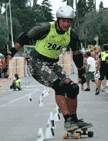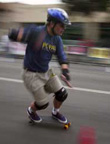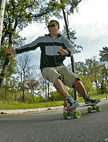Jani Soderhall wrote:Placing the tapeswitch half way down the ramp makes it difficult for racers to time their start with the beeps and estimating the time it takes to roll down half of the ramp. Wouldn't work.
The timing in Brixlegg worked just like anywhere else where Trackmate has been used in Europe: In the quals, individual clocks are being used. The beeps are only there to let the skaters know when they can go. In the elimination rounds, the clock is reset to dual racing mode and the time starts with the 4th beep.
For qualifications, which are virtually always individually timed, put the first tapeswitch halfway down the ramp or at the bottom of it. (As you mentioned, in Brixlegg they placed the switches at the bottom and it worked fine.) Any skater tries to "wheelie" over the switch in either of those places will likely hurt his/her time more than help it. Try it sometime: you'll see it's very difficult to do at all, much less to do effectively.
For dual racing (in which, as Jani mentioned, the timer starts with the last beep instead of by the tape switch) put the switches back at the top. It would take maybe an extra three minutes of time to do so.
Thus, in qualifying, nobody can gain an extra advantage, and in dual racing, you simply run over the switch at the start the way God intended.

Jani Soderhall wrote:Maybe that's what we should use until we have a technical solution in place. If you're seen doing it, you're penalized. The timer team could probably check it at least on bigger events.
Please don't seriously consider trying to have a "judge" determine whether someone lifted his/her wheels or not. It's complicated, subject to interpretation or bias, and requires yet another person to implement. (What if someone just takes an extra-hard pull and accidentally wheelies over the switch?) We don't have such judges any more (thank God!) for hitting the "wrong" side of a cone, because it's far too difficult to judge, and IMO, we shouldn't have them for this either.
Having thought about it further: Perhaps the best solution is to
prevent it in qualifying (by putting the tape switch at the bottom of the ramp), and simply
allow it in dual racing as part of the skill of anticipating the start. When combined with an effective false-start penalty (I recommend 2x for simplicity), I think any advantage gained would be very slight.

















